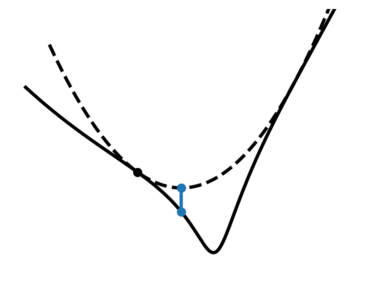Q-MM is a Python implementation of Majorize-Minimize Quadratic optimization algorithms. Algorithms provided here come from
[1] C. Labat and J. Idier, “Convergence of Conjugate Gradient Methods with a
Closed-Form Stepsize Formula,” J Optim Theory Appl, p. 18, 2008.
and
[2] E. Chouzenoux, J. Idier, and S. Moussaoui, “A Majorize–Minimize Strategy
for Subspace Optimization Applied to Image Restoration,” IEEE Trans. on
Image Process., vol. 20, no. 6, pp. 1517–1528, Jun. 2011, doi:
10.1109/TIP.2010.2103083.
See documentation for more background. If you use this code, please cite the references above and a citation of this toolbox will also be appreciated, see below. You can also click ⭐ on the repo.
The Q-MM optimization algorithms compute the minimizer of objective function like
J(x) = ∑ₖ μₖ ψₖ(Vₖ·x - ωₖ)
where x is the unknown vector, Vₖ a linear operator, ωₖ a fixed data, μₖ a scalar, ψₖ(u) = ∑ᵢφₖ(uᵢ), and φₖ a function that must be differentiable, even, coercive, φ(√·) concave, and 0 < φ'(u) / u < +∞.
The optimization is done thanks to quadratic sugorate function. In particular, no linesearch or sub-iteration is necessary, and close form formula for the step are used with guaranteed convergence.
A classical example, like in the figure below that show an image deconvolution problem, is the resolution of an inverse problem with the minimization of
J(x) = ||² + μ ψ(V·x)
where H is a low-pass forward model, V a regularization operator that approximate gradient (kind of high-pass filter) and ψ an edge preserving function like Huber. The above objective is obtained with k ∈ {1, 2}, ψ₁(·) = ||², V₁ = H, ω₁ = y, and ω₂ = 0.
- The
mmmg, Majorize-Minimize Memory Gradient algorithm. See documentation and [2] for details. - The
mmcg, Majorize-Minimize Conjugate Gradient algorithm. See documentation and [1] for details. - No linesearch: the step is obtained from a close form formula without sub-iteration.
- No conjugacy choice: a conjugacy strategy is not necessary
thanks to the subspace nature of the algorithms. The
mmcgalgorithm use a Polak-Ribière formula. - Generic and flexible: there is no restriction on the number of regularizer, their type, ..., as well as for data adequacy.
- Provided base class for objectives and losses allowing easy and fast implementation.
- Just one file if you like quick and dirty installation, but
available with
pip. - Comes with examples of implemented linear operator.
Q-MM is essentially just one file qmm.py. We recommend using poetry
for installation
poetry add qmm
The package can also be installed with pip. More options are described in the documentation.
Q-MM only depends on numpy and Python 3.6.
The demo.py presents an example on image deconvolution. The first step
is to implement the operators V and the adjoint Vᵀ as callable
(function or methods). The user is in charge of these operators and
these callable must accept a unique Numpy array x and a unique return
value
(partial
in the functools module in the standard library is usefull here).
There is no constraints on the shape, everything is vectorized
internally.
After import of qmm, user must instantiate Potential objects that
implement φ and Objective objects that implement μ ψ(V·x - ω)
import qmm
phi = qmm.Huber(delta=10) # φ
data_adeq = qmm.QuadObjective(H, Ht, HtH, data=data) # ||y - H·x||²
prior = qmm.Objective(V, Vt, phi, hyper=0.01) # μ ψ(V·x) = μ ∑ᵢ φ(vᵢᵗ·x)
Then you can run the algorithm
res = qmm.mmmg([data_adeq, prior], init, max_iter=200)
where [data_adeq, prior]{.sourceCode} means that the two objective
functions are summed. For more details, see
documentation.
- Source code: https://github.com/forieux/qmm
- Issue tracker: https://github.com/forieux/qmm/issues
If you are having issues, please let us know
orieux AT l2s.centralesupelec.fr
More information about me here. F. Orieux and R. Abirizk are affiliated to the Signal and Systems Laboratory L2S.
Q-MM has a DOI with Zenodo
.
Specific version can also be cited. Citation can be
François Orieux, & Ralph Abirizk. (2022). Q-MM: The Quadratic Majorize-Minimize
Python toolbox (v0.12.0). Zenodo. https://doi.org/10.5281/zenodo.6373070
A example of bibtex is
@software{francois_orieux_2022_6373070,
author = {François Orieux and Ralph Abirizk},
title = {Q-MM: The Quadratic Majorize-Minimize Python toolbox},
month = mar,
year = 2022,
publisher = {Zenodo},
version = {0.12.0},
doi = {10.5281/zenodo.6373069},
url = {https://doi.org/10.5281/zenodo.6373069}
}
Author would like to thanks J. Idier, S. Moussaoui and É. Chouzenoux. É. Chouzenoux has also a Matlab package that implements 3MG for image deconvolution that can be found on her webpage.
The project is licensed under the GPLv3 license.







